

SJSU - Music Theory, level 1A. Music Theory, level 1A (Adduci) MUSC 1A recommended reading list (Turek, Theory for Today's Musician): Ch. 1, 2, 3, 5 - fundamentals, intervals, chords Ch. 11, 12, 13, 14 - part writing Ch. 6 - cadences Ch. 8 - non-harmonic tones Ch. 4 - figured bass Optional reading: Ch. 7, 9, 10 - more information about form, melody, composition, phrasing Welcome to the MUSC 1A page!
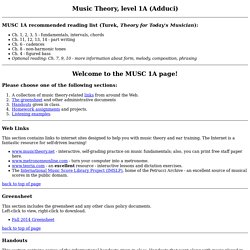
Please choose one of the following sections: A collection of music theory-related links from around the Web. Web Links This section contains links to internet sites designed to help you with music theory and ear training. Www.musictheory.net - interactive, self-grading practice on music fundamentals; also, you can print free staff paper here. www.metronomeonline.com - turn your computer into a metronome. www.teoria.com - an excellent resource - interactive lessons and dictation exercises. Theory Things. Read words, not lettersRhythm Dictation TipsRhythms, Simple Rhythm "Magic"Ritornello Form (under Rondo)Rondo FormRoman NumeralsRoman numeral Worksheet RoundRounded Binary Form Scale Degrees Name the Scale Degree (4 choices) Scales — Whole Steps & half stepsScore Reading at the KeyboardSecond Inversion TriadsSecondary Chords America Star spangled banner (1918 ed.)
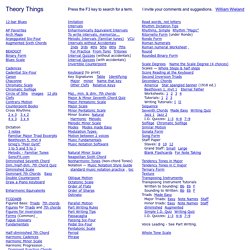
Beethoven 1, mvt 1 Eternal Father Worksheets: 1 2 3 4 Tutorials: 1 2 3 Writing Tutorials: I IISequenceSeventh Chords Made Easy Writing Quiz Jazz 1 Jazz 2 I.D. Quizzes: 1–3 4–6 7–9Solfège Chromatic SolfègeSimilar MotionSonata FormSong Form Staff Paper Staves: 8 10 12 Grand Staff: Small Large Blank Flashcards For Note Taking Tendency Tones in MajorTendency Tones in C majorTernary FormTextureTransposing Instruments Transposing Instrument Tutorials Written to Sounding: Bb Eb F Sounding to Written: Bb Eb F Triads Made Easy Major Triads: Easy Note Names Staff minor triads: Easy Note Names Staff diminished Augmented Simple I.D.
Texas Music Teachers Association. History of Music Notation - evolution, printing, specialisation and computers. Musical notation has been invented and re-invented several times, and has since gone through a rapid and accelerating process of evolution.
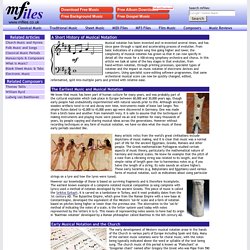
From basic indications of a simple song line going higher and lower, the complexity of musical notation has grown so that it can now specify in detail all the music for a 100-strong symphony orchestra and chorus. In this article we look at some of the key stages in that evolution, from hand-written notation, through printing processes, specialist types of notation and the impact on music notation of electronic devices and computers. Using specialist score-editing software programmes, that same orchesteral musical score can now be quickly changed, edited, reformatted, split into multiple parts and printed with relative ease. Texas Music Teachers Association. A Passion for Music Theory. Music Theory Teachers Toolbox. Classical Music Forms: Symphonic, Sonata, Theme and Variation & Rondo Forms. Music Theory. Music Theory Printable Worksheets Details. Details Written by Victoria Williams Sample pages from the printable PDF files you can download from My Music Theory.com Click here to download the full PDF files.

Click on any image to open the full size gallery. 300 Printable Music Worksheets to Download Now. Music Theory Worksheets. Finally!

Here are some music theory worksheets you can download and print. These will range from the most basic beginner level to more advanced challenges. Just a few things to test your knowledge of all things music. Musictheoryteacher.com - music theory teacher. Free VST plugins. Click for screenshot This VSTi plugin is a recreation of the famous ARP Odyssey.
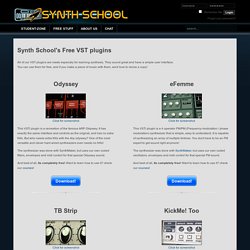
It has exactly the same interface and controls as the original, and has no extra frills. But who needs extra frills with the Arp odyssey? One of the most versatile and clever hard wired synthesizers ever needs no frills! The synthesizer was done with SynthMaker, but uses our own coded filters, envelopes and midi control for that special Odyssey sound. And best of all, its completely free! Click for screenshot This VSTi plugin is a 4 operator FM/PM (Frequency modulation / phase modulation) synthesizer that is simple, easy to understand. The synthesizer was done with SynthMaker, but uses our own coded oscillators, envelopes and midi control for that special FM sound. Free Music Theory Worksheets! Material on this page is free.NEW!
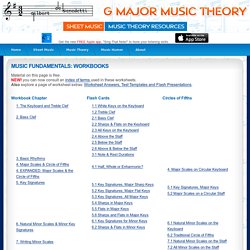
You can now consult an index of terms used in these worksheets.Also explore a page of worksheet extras: Worksheet Answers, Test Templates and Flash Presentations. Here are some testimonials from music teachers about these workbook chapters: I have been using your fantastic music theory sheets and PDF downloads to teach high school piano theory to 28 students per class, all of whom are at different levels of study and accomplishment. Your method is comprehensive and easily accessible to students of all ages. What a great philanthropist and talented musician you are and it is indeed a pleasure to have discovered that I can thank you (in person) on Facebook ... I am excited about the way my students have received this material. Joyce T. Hi, I am a High School teacher in California and I found your Theory Website. Material on this page is free.NEW! Worksheets for Teachers. Elements of Music. Elements of Music Pitch – register (high or low); Organization of pitches with a pattern of intervals between them creates scales; Words we might use to describe scales: major/minor, chromatic, gapped, pentatonic.
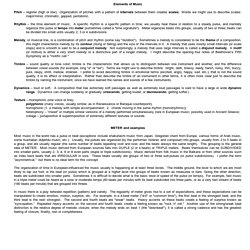
Rhythm – the time element of music. A specific rhythm is a specific pattern in time; we usually hear these in relation to a steady pulse, and mentally organize this pulse or tempo into meter (sometimes called a "time signature"). Meter organizes beats into groups, usually of two or three; beats can be divided into small units usually 2, 3 or 4 subdivisions Melody, or musical line, is a combination of pitch and rhythm (some say "duration"). Timbre – sound quality or tone color; timbre is the characteristic that allows us to distinguish between one instrument and another, and the difference between vowel sounds (for example, long "a" or "ee").
Dynamics – loud or soft. Free sheet music on 8notes.com. Raindrop. Glossary of Musical Terms. Fun beats. Mode (music) Modern Dorian mode on C Play Early Greek treatises on music do not use the term "mode" (which comes from Latin), but do describe three interrelated concepts that are related to the later, medieval idea of "mode": (1) scales (or "systems"), (2) tonos—pl. tonoi—(the more usual term used in medieval theory for what later came to be called "mode"), and (3) harmonia (harmony)—pl. harmoniai—this third term subsuming the corresponding tonoi but not necessarily the converse (Mathiesen 2001a, 6(iii)(e)).
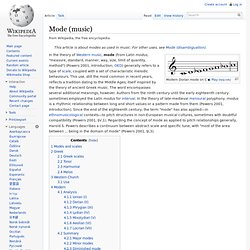
Greek Dorian octave species in the enharmonic genus, showing the two component tetrachords Play Greek Dorian octave species in the chromatic genus Play Greek Dorian octave species in the diatonic genus Play. Music Theory Worksheets. Free Music Theory Worksheets - Music Bumblebees. Music Theory for Musicians and Normal People.pdf. DIY: Silent Mini Keyboards. I recently decided that I wanted to own a set of silent keyboards for doing introductory piano activities with young children, and for using during group theory activities.

Unfortunately, buying a set of silent plastic keyboards (view them at musicinmotion.com) can be a rather large studio expense. Of course, a cheap alternative would be to simply print a picture of a keyboard on paper. But there is something nice about the 3D features of a silent keyboard…so I decided to make my own.
I got the idea from Anne Cosby Gaudet’s Piano Discoveries website, where she made similar keyboards with wood and foam. Music Theory for Musicians and Normal People. By Toby W. Rush This page includes links to each of the individual Music Theory pages I've created in PDF form. This is a work in progress; I am writing new ones regularly and fixing errors and omissions on existing ones as I find them. If you find them useful for your theory studies, you are welcome to use them, and if you find errors or have suggestions, I invite you to contact me.
Enjoy! These pages are available for free under a Creative Commons BY-NC-ND license. Wp-content/files/Piano_Keyboard_Printable.pdf. ComposeCreate.com Creative Piano Teaching. Piano.